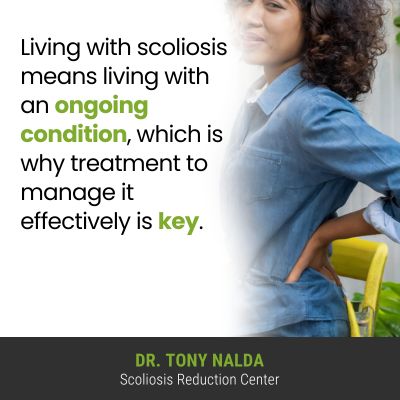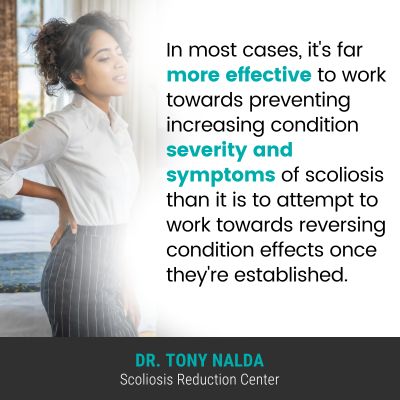As a progressive condition, the nature of scoliosis is to get worse over time, and if severe and/or if left untreated, it can lead to complications and the need for invasive surgical treatment in the future. As scoliosis is incurable, treatment is more about managing an ongoing condition.
Scoliosis is a progressive spinal condition that involves the development of an unnatural sideways-bending and twisting spinal curve, and it’s always a cause for concern. The best way to minimize the effects of scoliosis is to treat it proactively.
While there are never treatment guarantees, people who are proactively treating their scoliosis have less to worry about because early detection and intervention is associated with treatment success.
What Does a Scoliosis Diagnosis Mean?
With current estimates at close to seven million people living with scoliosis in the United States alone, it is a highly-prevalent spinal condition.
Being diagnosed with scoliosis means an unnatural spinal curve that bends to the side and twists unnaturally has developed.
In addition, as a progressive condition, a diagnosis of scoliosis means it’s virtually guaranteed to get worse at some point, although there is no 100-percent reliable means of determining which cases will progress, which won’t, and at what rate.

Living with scoliosis means living with an ongoing condition, which is why treatment to manage it effectively is key.
A scoliosis diagnosis will also further specify details about a patient’s condition that treatment plans can be shaped around; the complex nature of scoliosis necessitates the full customization of effective treatment plans.
The more severe a condition is, the more likely it is to continue progressing, the more noticeable its effects are likely to be, and the more complex it is to treat, so when it comes to how worried a person should be about their condition, severity is an important factor.
Scoliosis Severity
Every case of scoliosis is unique and can range in severity from mild to moderate and severe to very severe scoliosis.
Severity is determined by a patient’s Cobb angle: a measurement taken during X-ray that tells me how large the unnatural spinal curve is, how much rotation there is, and how far out of alignment the scoliotic spine is.
When the spine’s natural and healthy curves are in place, its vertebrae (bones) are aligned in a straight and neutral position as they should be.
The higher a patient’s Cobb angle, the more severe the condition:
- Mild scoliosis: Cobb angle measurement of between 10 and 25 degrees
- Moderate scoliosis: Cobb angle measurement of between 25 and 40 degrees
- Severe scoliosis: Cobb angle measurement of 40+ degrees
- Very-severe scoliosis: Cobb angle measurement of 80+ degrees
As scoliosis progresses, it’s getting more severe: the unnatural spinal curve is increasing in size, as are the condition’s uneven forces, and their effects.
In addition to condition severity, condition type is another key factor that affects severity.
Different Types of Scoliosis
Part of the reason scoliosis is so often deemed a complex condition to treat is because it’s such a highly-variable condition; not only does it range so widely in severity, there are also multiple different types of scoliosis patients can develop.
Condition type is determined by causation, whether unknown or known.
The most common type of scoliosis to affect all ages is idiopathic scoliosis, and idiopathic means not clearly associated with a single-known cause, and this accounts for approximately 80 percent of known cases.
The remaining 20 percent of known cases are associated with known causes: neuromuscular scoliosis, congenital scoliosis, and degenerative scoliosis.
Scoliosis also affects all ages, but the most prevalent type overall is adolescent idiopathic scoliosis, diagnosed between the ages of 10 and 18.
So idiopathic scoliosis is considered typical, and the types with known causes are considered atypical, and this can make them more severe and concerning.
In typical scoliosis cases, the curve will bend to the right, away from the heart, but in atypical cases, the unnatural curvature of the spine can bend to the left, towards the heart.
When I see a left-bending curvature of the spine on an X-ray, this is a red flag for me that their is an underlying pathology causing the scoliosis to develop, and this complicates treatment options.
While a left-bending curve is likely to be more severe and worrying, the earlier treatment is started, the more likely it is that improvements can be made, in most cases of scoliosis.
A condition type that’s particularly concerning for patients is neuromuscular scoliosis (NMS), and this is because it’s caused by the presence of a larger neuromuscular condition, so the underlying neuromuscular condition has to be the focus of treatment.
Neuromuscular scoliosis can be caused by a number of neuromuscular conditions such as cerebral palsy, muscular dystrophy, and spina bifida, to name a few.
Cases of NMS can progress quickly because they are caused by a larger condition that involves a disconnect between the brain, the spine’s supportive muscles, and connective tissues that support the spine.
My NMS patients are among the most difficult to treat, with some becoming nonambulatory (unable to walk on their own), but I always approach treatment with positivity that improvements to overall quality of life can be worked towards.
Every Case of Scoliosis Benefits from Treatment
The challenge of living with a progressive spinal condition can’t be underestimated, but while scoliosis is incurable and can become severe, it can also be highly treatable, especially if an early diagnosis is met with a proactive treatment approach.
So the best way to minimize the condition’s effects is to respond with proactive treatment started as close to the time of diagnosis as possible, and this is beneficial because, as mentioned, scoliosis only gets more complex to treat the more severe it becomes.

In most cases, it’s far more effective to work towards preventing increasing condition severity and symptoms of scoliosis than it is to attempt to work towards reversing condition effects once they’re established.
When it comes to childhood scoliosis, the main condition effect is abnormal posture, and in adults, it’s pain caused by compression; scoliosis doesn’t become a compressive condition until skeletal maturity is reached.
Even if mild, patients can still benefit from staring treatment immediately because it can mean counteracting the condition’s progressive nature, and proactive treatment is the best way to manage curve progression.
Virtually all cases of scoliosis require treatment at some point, and a proactive conservative treatment approach combines multiple scoliosis-specific treatment disciplines so treatment plans can be fully customized and adjusted based on how the spine is responding to treatment and/or growth.
Growth is what triggers scoliosis to get worse, which is why scoliosis in children should be taken seriously; younger patients who still have growth yet to go through are the most at risk for continued progression and rapid-phase progression due to rapid and unpredictable growth spurts of puberty.
Many patients with severe scoliosis or who have left their scoliosis untreated, are at risk for developing complications such as breathing problems, digestive issues, and/or those related to a surgical treatment response.
Modern conservative treatment combines chiropractic care, physical therapy, corrective bracing, and rehabilitation, while traditional scoliosis treatment doesn’t have a strategy for addressing scoliosis while mild, but commonly responds with a spinal fusion recommendation when/if a patient’s scoliosis becomes severe.
Conclusion
A scoliosis diagnosis should always be a concern because as a progressive condition, it’s incurable, but it can be highly treatable.
When it comes to childhood scoliosis, this is particularly concerning because while we don’t fully understand what triggers the onset of most cases of scoliosis in children, we do understand what makes them progress: growth.
The more growth a young patient has to go through, the more potential progression they are at risk for; curve progression occurs in adult scoliosis, but the rates tend to slow because the progressive trigger of growth is removed.
It is important to understand, however, that adults still need to worry about progression, particularly in older adults facing natural age-related spinal degeneration: degenerative scoliosis.
People who should worry about developing scoliosis are those that have certain risk factors, such as if someone else in the family has been diagnosed; a family history doesn’t guarantee subsequent diagnoses because scoliosis isn’t genetic, but it is familial.
A family history increases the likelihood of a diagnosis, but this is understood as the condition being familial: sharing a lot of different factors that could contribute to the condition’s development.
Families share a lot more than just their genes, so having scoliosis in the family is a risk factor that warrants awareness, regular physical examination, and screening.
A medical history of medical conditions affecting the spine running in the family is another risk factor for scoliosis.
When it comes to scoliosis in children, while there are no treatment guarantees, scoliosis that’s diagnosed and treated prior to the first pubescent growth spurt is when treatment can make the biggest impact.
While there is no known way to prevent scoliosis, with early detection and intervention, there are fewer limits to what treatment can achieve, and one of the biggest benefits to a proactive treatment approach is that many patients can avoid having spinal fusion surgery and living with metal rods attached to the spine.




